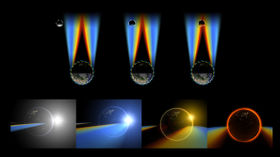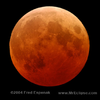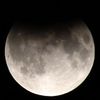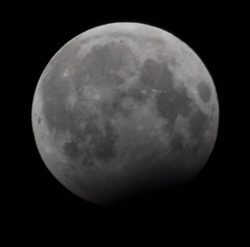Lunar eclipse






A lunar eclipse occurs when the moon passes behind the earth such that the earth blocks the sun’s rays from striking the moon. This can occur only when the Sun, Earth and Moon are aligned exactly, or very closely so, with the Earth in the middle. Hence, there is always a full moon the night of a lunar eclipse. The type and length of an eclipse depend upon the Moon’s location relative to its orbital nodes. The next total lunar eclipse will occur on December 21, 2010. Unlike a solar eclipse, which can only be viewed from a certain relatively small area of the world, a lunar eclipse may be viewed from anywhere on the night side of the Earth. A lunar eclipse lasts for a few hours, whereas a total solar eclipse lasts for only a few minutes at any given place. Some lunar eclipses have been associated with important historical events.
Contents |
Types of lunar eclipses
The shadow of the Earth can be divided into two distinctive parts: the umbra and penumbra. Within the umbra, there is no direct solar radiation. However, as a result of the Sun’s large angular size, solar illumination is only partially blocked in the outer portion of the Earth’s shadow, which is given the name penumbra.
A penumbral eclipse occurs when the Moon passes through the Earth’s penumbra. The penumbra causes a subtle darkening of the Moon's surface. A special type of penumbral eclipse is a total penumbral eclipse, during which the Moon lies exclusively within the Earth’s penumbra. Total penumbral eclipses are rare, and when these occur, that portion of the Moon which is closest to the umbra can appear somewhat darker than the rest of the Moon.
A partial lunar eclipse occurs when only a portion of the Moon enters the umbra. When the Moon travels completely into the Earth’s umbra, one observes a total lunar eclipse. The Moon’s speed through the shadow is about one kilometer per second (2,300 mph), and totality may last up to nearly 107 minutes. Nevertheless, the total time between the Moon’s first and last contact with the shadow is much longer, and could last up to 3.8 hours.[1] The relative distance of the Moon from the Earth at the time of an eclipse can affect the eclipse’s duration. In particular, when the Moon is near its apogee, the farthest point from the Earth in its orbit, its orbital speed is the slowest. The diameter of the umbra does not decrease much with distance. Thus, a totally eclipsed Moon occurring near apogee will lengthen the duration of totality.
A selenelion or selenehelion occurs when both the Sun and the eclipsed Moon can be observed at the same time. This can only happen just before sunset or just after sunrise, and both bodies will appear just above the horizon at nearly opposite points in the sky. This arrangement has led to the phenomenon being referred to as a horizontal eclipse. It happens during every lunar eclipse at all those places on the Earth where it is sunrise or sunset at the time. Indeed, the reddened light that reaches the Moon comes from all the simultaneous sunrises and sunsets on the Earth. Although the Moon is in the Earth’s geometrical shadow, the Sun and the eclipsed Moon can appear in the sky at the same time because the refraction of light through the Earth’s atmosphere causes objects near the horizon to appear higher in the sky than their true geometric position.[2]
The Moon does not completely disappear as it passes through the umbra because of the refraction of sunlight by the Earth’s atmosphere into the shadow cone; if the Earth had no atmosphere, the Moon would be completely dark during an eclipse. The red coloring arises because sunlight reaching the Moon must pass through a long and dense layer of the Earth’s atmosphere, where it is scattered. Shorter wavelengths are more likely to be scattered by the air molecules and the small particles, and so by the time the light has passed through the atmosphere, the longer wavelengths dominate. This resulting light we perceive as red. This is the same effect that causes sunsets and sunrises to turn the sky a reddish color; an alternative way of considering the problem is to realize that, as viewed from the Moon, the Sun would appear to be setting (or rising) behind the Earth.
The amount of refracted light depends on the amount of dust or clouds in the atmosphere; this also controls how much light is scattered. In general, the dustier the atmosphere, the more that other wavelengths of light will be removed (compared to red light), leaving the resulting light a deeper red color. This causes the resulting coppery-red hue of the Moon to vary from one eclipse to the next. Volcanoes are notable for expelling large quantities of dust into the atmosphere, and a large eruption shortly before an eclipse can have a large effect on the resulting color.
Danjon scale
The following scale (the Danjon scale) was devised by André Danjon for rating the overall darkness of lunar eclipses:[3]
- L=0: Very dark eclipse. Moon almost invisible, especially at mid-totality.
- L=1: Dark Eclipse, gray or brownish in coloration. Details distinguishable only with difficulty.
- L=2: Deep red or rust-colored eclipse. Very dark central shadow, while outer edge of umbra is relatively bright.
- L=3: Brick-red eclipse. Umbral shadow usually has a bright or yellow rim.
- L=4: Very bright copper-red or orange eclipse. Umbral shadow is bluish and has a very bright rim.
Eclipse cycles
Every year there are at least two lunar eclipses, although total lunar eclipses are significantly less common. If one knows the date and time of an eclipse, it is possible to predict the occurrence of other eclipses using an eclipse cycle like the Saros cycle.
Recent and forthcoming lunar eclipse events
- March 3, 2007, lunar eclipse ― The first total lunar eclipse of 2007 occurred on March 3, 2007, and was partially visible from the Americas, Asia and Australia. The complete event was visible throughout Africa and Europe. The event lasted 01h:15m, began at 20:16 UTC, and reached totality at 22:43 UTC.[4]
- August 2007 lunar eclipse ― August 28, 2007, saw the second total lunar eclipse of the year. The initial stage began at 07:52 UTC, and reached totality at 09:52 UTC. This eclipse was viewable form Eastern Asia, Australia and New Zealand the Pacific, and the Americas.[5]
- February 2008 lunar eclipse ― The only total lunar eclipse of 2008 occurred on February 21, 2008, beginning at 01:43 UTC, visible from Europe, the Americas, and Africa.[6]
- There was a partial eclipse of the Moon on December 31, 2009.
- There was a partial eclipse of the Moon on June 26, 2010.
- The next total eclipse of the Moon will occur on December 21, 2010.
1995-1998
| Ascending node | Descending node | |||||
|---|---|---|---|---|---|---|
| Saros Photo |
Date Viewing |
Type Chart |
Saros Photo |
Date Viewing |
Type Chart |
|
| 112 | 1995 Apr 15 |
Partial |
117 | 1995 Oct 08 |
Penumbral |
|
| 122 | 1996 Apr 04 |
Total |
127 | 1996 Sep 27 |
Total |
|
132 |
1997 Mar 24 |
Partial |
137 | 1997 Sep 16 |
Total |
|
| 142 | 1998 Mar 13 |
Penumbral |
147 | 1998 Sep 06 |
Penumbral |
|
| Last set | 1994 May 25 | Last set | 1994 Nov 18 | |||
| Next set | 1999 Jan 31 | Next set | 1998 Aug 08 | |||
1998-2002
| Descending node | Ascending node | |||||
|---|---|---|---|---|---|---|
| Saros | Date Viewing |
Type Chart |
Saros | Date Viewing |
Type Chart |
|
| 109 | 1998 Aug 08 |
Penumbral |
114 | 1999 Jan 31 |
Penumbral |
|
| 119 | 1999 Jul 28 |
Partial |
124 | 2000 Jan 21 |
Total |
|
| 129 | 2000 Jul 16 |
Total |
134 | 2001 Jan 09 |
Total |
|
| 139 | 2001 Jul 05 |
Partial |
144 | 2001 Dec 30 |
Penumbral |
|
| 149 | 2002 Jun 24 |
Penumbral |
||||
| Last set | 1998 Sep 06 | Last set | 1998 Mar 13 | |||
| Next set | 2002 May 26 | Next set | 2002 Nov 20 | |||
2002–2005
| Descending node | Ascending node | |||||
|---|---|---|---|---|---|---|
| Saros Photo |
Date View |
Type Chart |
Saros Photo |
Date View |
Type Chart |
|
| 111 | 2002 May 26 |
penumbral |
116 | 2002 Nov 20 |
penumbral |
|
121 |
2003 May 16 |
total |
126 |
2003 Nov 09 |
total |
|
131 |
2004 May 04 |
total |
136 |
2004 Oct 28 |
total |
|
141 |
2005 Apr 24 |
penumbral |
146 | 2005 Oct 17 |
partial |
|
| Last set | 2002 Jun 24 | Last set | 2001 Dec 30 | |||
| Next set | 2006 Mar 14 | Next set | 2006 Sep 7 | |||
2006–2009
| Descending node | Ascending node | |||||
|---|---|---|---|---|---|---|
| Saros Photo |
Date Viewing |
Type Chart |
Saros Photo |
Date Viewing |
Type Chart |
|
113 |
2006 Mar 14 |
penumbral |
118 |
2006 Sep 7 |
partial |
|
123 |
2007 Mar 03 |
total |
128 |
2007 Aug 28 |
total |
|
133 |
2008 Feb 21 |
total |
138 |
2008 Aug 16 |
partial |
|
143 |
2009 Feb 9 |
penumbral |
148 |
2009 Aug 06 |
penumbral |
|
| Last set | 2005 Apr 24 | Last set | 2005 Oct 17 | |||
| Next set | 2009 Dec 31 | Next set | 2009 Jul 07 | |||
2009–2013
| Ascending node | Descending node | |||||
|---|---|---|---|---|---|---|
| Saros | Date Viewing |
Type chart |
Saros | Date Viewing |
Type chart |
|
| 110 | 2009 July 07 |
penumbral |
115 |
2009 Dec 31 |
partial |
|
120 |
2010 June 26 |
partial |
125 | 2010 Dec 21 |
total |
|
| 130 | 2011 June 15 |
total |
135 | 2011 Dec 10 |
total |
|
| 140 | 2012 June 04 |
partial |
145 | 2012 Nov 28 |
penumbral |
|
| 150 | 2013 May 25 |
penumbral |
||||
| Last set | 2009 Aug 06 | Last set | 2009 Feb 9 | |||
| Next set | 2013 Apr 25 | Next set | 2013 Oct 18 | |||
2013–2016
| Ascending node | Descending node | |||||
|---|---|---|---|---|---|---|
| Saros | Date Viewing |
Type | Saros | Date Viewing |
Type | |
| 112 | 2013 Apr 25 |
Partial |
117 | 2013 Oct 18 |
Penumbral |
|
| 122 | 2014 Apr 15 |
Total |
127 | 2014 Oct 08 |
Total |
|
| 132 | 2015 Apr 04 |
Total |
137 | 2015 Sep 28 |
Total |
|
| 142 | 2016 Mar 23 |
Penumbral |
147 | 2016 Sep 16 |
Penumbral |
|
| Last set | 2013 May 25 | Last set | 2012 Nov 28 | |||
| Next set | 2017 Feb 31 | Next set | 2016 Aug 08 | |||
2016–2020
| Descending node | Ascending node | |||||
|---|---|---|---|---|---|---|
| Saros | Date | Type Viewing |
Saros | Date Viewing |
Type Chart |
|
| 109 | 2016 Aug 18 |
Penumbral |
114 | 2017 Feb 11 |
Penumbral |
|
| 119 | 2017 Aug 07 |
Partial |
124 | 2018 Jan 31 |
Total |
|
| 129 | 2018 Jul 27 |
Total |
134 | 2019 Jan 21 |
Total |
|
| 139 | 2019 Jul 16 |
Partial |
144 | 2020 Jan 10 |
Penumbral |
|
| 149 | 2020 Jul 05 |
Penumbral |
||||
| Last set | 2016 Sep 16 | Last set | 2016 Mar 23 | |||
| Next set | 2020 Jun 05 | Next set | 2020 Nov 30 | |||
See also
- Lunar eclipses in history
- May 1453 lunar eclipse - Fall of Constantinople
- March 1504 lunar eclipse - Columbus’ lunar eclipse
- December 1573 lunar eclipse - Tycho Brahe
- Eclipse
- Moon illusion
- Orbit of the Moon
- Solar eclipse
- Umbra
References
- ↑ Hannu Karttunen. Fundamental Astronomy. Springer. http://books.google.com/books?id=DjeVdb0sLEAC&pg=PA139&lpg=PA139&dq=lunar+eclipse+%22maximum+duration%22&source=web&ots=2g2ku9x57X&sig=x5J8rF3DEVu4-TkJGhYr9LhW_GQ.
- ↑ John Hammond (May 15, 2003). "Weather Centre: Astronomical event threatened by the Great British weather". BBC News. http://www.bbc.co.uk/weather/ukweather/daily_review/news/15052003news.shtml. Retrieved 2008-02-20.
- ↑ Paul Deans and Alan M. MacRobert. "Observing and Photographing Lunar Eclipses". Sky and Telescope. http://skytonight.com/observing/objects/eclipses/3304036.html.
- ↑ "Total Lunar Eclipse: March 3, 2007". NASA Eclipse Page. NASA. 2008. http://sunearth.gsfc.nasa.gov/eclipse/OH/OH2007.html. Retrieved 2008-02-20.
- ↑ "Total Lunar Eclipse: August 28, 2007". NASA Eclipse Page. NASA. 2008. http://sunearth.gsfc.nasa.gov/eclipse/LEmono/TLE2007Aug28/TLE2007Aug28.html. Retrieved 2008-02-20.
- ↑ "Total Lunar Eclipse: February 20, 2008". NASA Eclipse Page. NASA. 2008. http://sunearth.gsfc.nasa.gov/eclipse/LEmono/TLE2008Feb21/TLE2008Feb21.html. Retrieved 2008-02-20.
- Bao-Lin Liu, Canon of Lunar Eclipses 1500 B.C.-A.D. 3000, 1992
- Jean Meeus and Hermann Mucke Canon of Lunar Eclipses. Astronomisches Büro, Vienna, 1983
- Espenak, F., Fifty Year Canon of Lunar Eclipses: 1986-2035. NASA Reference Publication 1216, 1989
External links
- Animated explanation of the mechanics of a lunar eclipse, University of Glamorgan
- Lunar Eclipse time sequence
- U.S. Navy Lunar Eclipse Computer
- NASA Eclipse home page
- Search among the 12,064 lunar eclipses over five millennium and display interactive maps
- Lunar Eclipses for Beginners
- Shadow and Substance for animation of future and past eclipses
- Tips on photographing the lunar eclipse from New York Institute of Photography
- E-mail notification on upcoming eclipses
|
||||||||||||||||||||||||||
|
|||||||||||||||||||||||
